Native name 中央本線 Line length 424.6 km (263.8 mi) Stations 112 | Opened 1889 Track gauge 1,067 mm (3 ft 6 in) | |
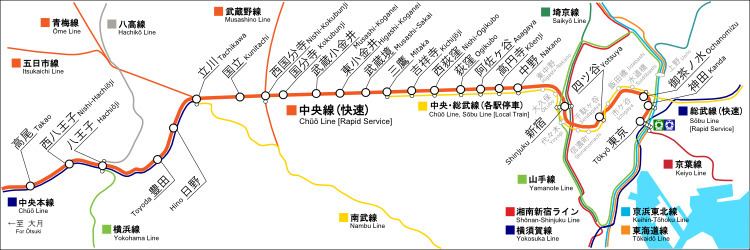 | ||
Electrification 1,500 V DC Overhead lines | ||
Japan railway jr chuo main line e257 series e256 1 azusa hachioji station 2 28 2014
The Chūō Main Line (中央本線, Chūō-honsen), commonly called the Chūō Line, is one of the major trunk railway lines in Japan. It connects Tokyo and Nagoya, although it is the slowest direct railway connection between the two cities; the coastal Tōkaidō Main Line is slightly faster, and the Tōkaidō Shinkansen is the fastest rail link between the cities.
Contents
- Japan railway jr chuo main line e257 series e256 1 azusa hachioji station 2 28 2014
- Routes
- Stations and services
- Tokyo Mitaka
- Mitaka Takao
- Takao Shiojiri
- Okaya Shiojiri
- Shiojiri Nakatsugawa
- Nakatsugawa Nagoya
- Signals and junctions
- Ch East Line JR East
- Ch West Line JR Central
- Freight train
- History
- Former connecting lines
- Proposed connecting lines
- Accidents
- References

The eastern portion, the Chūō East Line (中央東線, Chūō-tōsen), is operated by the East Japan Railway Company (JR East), while the western portion, the Chūō West Line (中央西線, Chūō-saisen), is operated by the Central Japan Railway Company (JR Central). The dividing point between the two companies is Shiojiri Station, where express trains from both operators continue to the Shinonoi Line towards the cities of Matsumoto and Nagano. Compared to the huge urban areas at either end of the Chūō Line, its central portion is very lightly traveled; the Shiojiri-Nakatsugawa corridor is only served by twice-hourly local and hourly limited express trains.

The Chūō Main Line passes through the mountainous center of Honshu. Its highest point (near Fujimi Station) is about 900 meters above sea level and much of the line has a gradient of 25 per mil (2.5% or 1 in 40). Along the Chūō East Line section, peaks of the Akaishi and Kiso as well as Mount Yatsugatake can be seen from trains. The Chūō West Line parallels the old Nakasendō highway (famous for the preserved post towns of Tsumago-juku and Magome-juku) and the steep Kiso Valley.
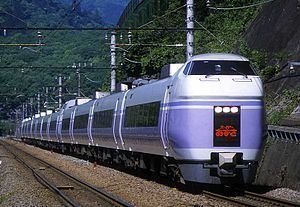
Routes
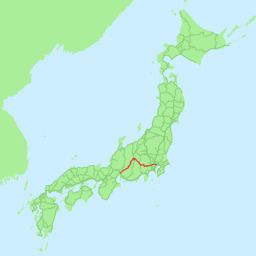
Stations and services
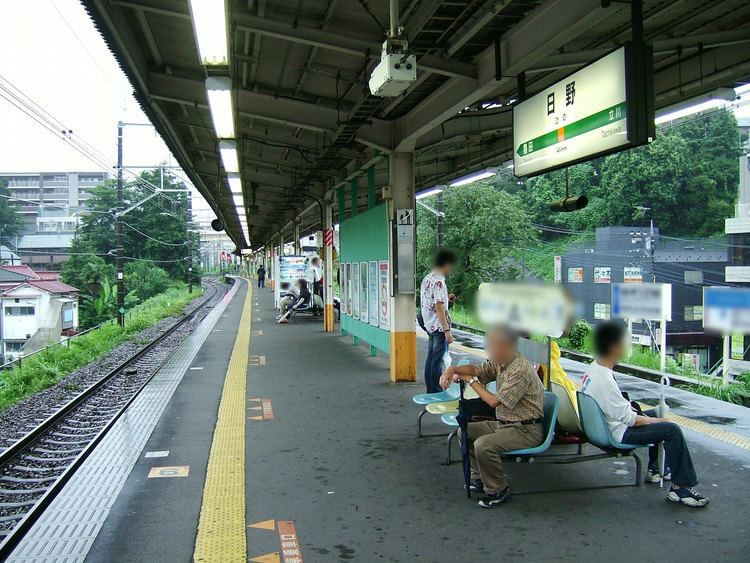
This section lists all stations on the Chūō Main Line and generally explains regional services on the line. In addition, there are limited express services connecting major cities along the line, namely Azusa, Super Azusa, Kaiji, Hamakaiji, Narita Express and Shinano. For details of the limited express trains, see the relevant articles.
Tokyo - Mitaka
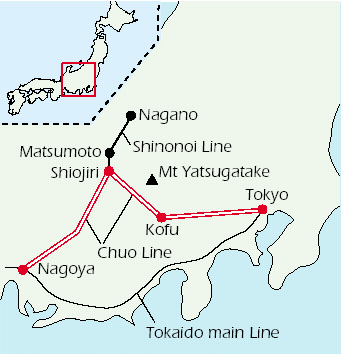
The section between Tokyo and Mitaka is grade-separated, with no level crossings. Between Ochanomizu and Mitaka, the Chūō Main Line has four tracks; two of them are local tracks (緩行線, kankō-sen) with platforms at every station; the other two are rapid tracks (快速線, kaisoku-sen) with some stations without platforms. The local tracks are used by the main line local trains (operated only in early morning and late night) and the Chūō-Sōbu Line local trains, while the rapid tracks carry rapid service and limited express trains. The Tokyo-Mitaka portion is a vital cross-city rail link.
The commuter services on the rapid tracks are collectively called the Chūō Line (Rapid) in comparison with the Chūō Line (Local) (中央線各停, Chūō-sen-kakutei) or the Chūō-Sōbu Line on the local tracks. The former is usually referred to simply as the Chūō Line and the latter the Sōbu Line. Separate groups of trainsets are used for these two groups of services: cars with an orange belt for the rapid service trains and cars with a yellow belt for the local service trains, with the exception of early morning and late night local service trains which use cars with an orange belt. Signs at stations also use these colors to indicate the services.
This section is located entirely within Tokyo.
Legends for the table
Mitaka - Takao
The four-track section ends at Mitaka. Construction is underway between Mitaka and Tachikawa to elevate the tracks and eliminate level crossings; this section of the line was notorious for its level crossings which can be shut for upwards of an hour during rush hour. Plans have been proposed to add another two tracks as far as Tachikawa, but were not included in the track elevation, which was completed between 2008-2011, with further modifications in 2012.
This section is also entirely in Tokyo. For legends on train types, see the preceding section.
Takao - Shiojiri
Most of the rapid service trains from Tokyo terminate at Takao where the line exits the large urban area of Tokyo. The section between Takao and Ōtsuki still carries some commuter trains as well as long distance local trains and Limited Express trains. The Kaiji limited express terminates at Kōfu, the capital of Yamanashi Prefecture, while the Azusa and Super Azusa continue beyond Shiojiri to Matsumoto via the Shinonoi Line.
Okaya – Shiojiri
The Okaya-Shiojiri branch is an old route of the Chūō Main Line. It carries a small number of shuttle trains and trains from/to the Iida Line, which branches off at Tatsuno.
Prior to the opening of the new route between Okaya and Shiojiri, there was a junction (Higashi-Shiojiri Junction (東塩尻信号場)) between Ono and Shiojiri stations. It had a reversing layout. The signal station was closed on October 12, 1983.
Shiojiri - Nakatsugawa
Shiojiri is the dividing point of the East Line and the West Line; no train continues from one to the other. The Shinano limited express is the main service for the rural Shiojiri-Nakatsugawa section.
Nakatsugawa - Nagoya
Local and rapid service trains run on the line from Nakatsugawa to Nagoya. This section carries urban traffic for the Greater Nagoya Area.
Legends:
Signals and junctions
Chūō East Line (JR East)
New E233 series trains entered service on Tokyo-area commuter services from 26 December 2006. These trains are a development of the E231 series used on other commuter lines in the Tokyo area, and replaced the aging 201 series rolling stock introduced on the line in 1981.
From 2016, new E353 series EMUs are scheduled to be introduced on Azusa and Super Azusa limited express services, replacing the E351 and E257 series trains.
Chūō West Line (JR Central)
Freight train
History
The Kobu Railway (甲武鉄道) opened the initial section of the Chūō Line from Shinjuku Station to Tachikawa Station in 1889. The company then extended the line both westward and eastward (towards Tokyo) until it was nationalised in 1906. The Japanese Government Railways (JGR) then continued to extend the line, reaching Shiojiri the same year, and Tokyo (at Shōheibashi Station (昌平橋駅)) in 1908. The JGR also built the line from Nagoya, the first section opening in 1900, with the lines connecting in 1911. The Table below gives the section opening dates.
In 1904, the section between Iidamachi Station (formerly located between Suidōbashi Station and Iidabashi Station) and Nakano Station was the first urban electric railway in Japan using 600 V DC. Electrification was extended in 1919 and 1922, was increased to 1,200 V DC when extended to Tokyo in 1927, boosted again to 1,500 V DC in 1929, and reached Kofu in 1931. Electrification from the Nagano end was commissioned in sections from 1966, and the entire line was electrified by 1973.
Notes:
Former connecting lines
Proposed connecting lines
Accidents
On September 12, 1997, a Super Azusa limited express bound for Matsumoto collided with a 201 series local train that failed to stop at a red signal while passing through Ōtsuki Station.
